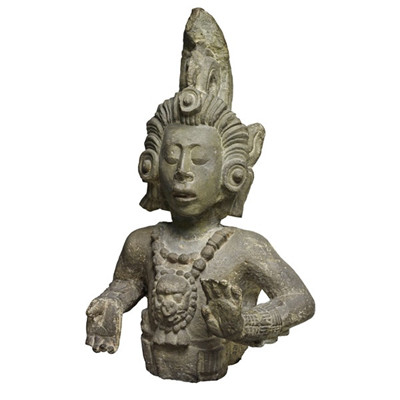Across the world, people began to identify particular plants that would provide them with food. In the Middle East-as we saw in the last programme-it was wheat and barley; in China millet and rice; in Papua New Guinea taro; and in Africa sorghum. And, as they did so, everywhere stories about gods emerged; gods of death and of rebirth, gods who would guarantee the cycle of the seasons and ensure the return of the crops, and gods-more importantly-that represent food itself. Today's object is myth-made material; a food god from Central America.
在世界各地,人類開(kāi)始學(xué)會(huì)識(shí)別特定的植物,當(dāng)成提供食物的農(nóng)作物。在中東,我們?cè)谏掀诠?jié)目中已經(jīng)看到的,出現(xiàn)的是小麥和大麥;在中國(guó),小米和大米;在巴布亞新幾內(nèi)亞是芋頭;在非洲是高粱。隨著這些作物的降臨,涌現(xiàn)出各種各樣的神靈與相關(guān)他們的故事,死神、重生之神、掌管季節(jié)變換之神、保佐豐收之神,以及最最重要的,代表食物本身的神靈。今天要介紹的物品就是充滿了神話色彩,一位來(lái)自中美洲的食物之神。
Here, in the heart of the British Museum, we have a god of maize. He's a bust, carved of limestone using a stone chisel and a basalt hammer, and the features are large, symmetrical, the eyes closed, the lips parted-as though this god is in communion with a different world, quietly meditating.
在大英博物館的中央,我們有一尊玉米之神。他是一件胸像,使用石鑿和玄武巖錘在一塊石灰石上雕刻出來(lái)的。五官宏大,左右對(duì)稱,雙眼緊閉,嘴唇分開(kāi),仿佛這位神靈正在與另一個(gè)世界進(jìn)行溝通,沉浸在冥想中。
The arms are bent, the palms of the hands face outwards-one raised, one lower-giving an impression of serene power. The head of the god is covered with an enormous headdress in the shape of a stylised corn cob, and his hair is like the silky strands that line the inside of a cob of corn, inside the wrapping leaves.
雙臂彎曲,雙掌手頭向上,一只抬高,一只較低;讓人感覺(jué)到一股安祥而強(qiáng)大的力量。神像頭部覆蓋著一個(gè)巨大的頭飾,具有很強(qiáng)裝飾色彩的玉米芯形狀,他的頭發(fā)就像是玉米須,絲綢般的,跟玉米芯一起被包裹在重重疊疊的玉米葉里。
Originally this statue would have sat with many other similar gods high up on a stepped pyramid-style temple in western Honduras. He was found in Copan, a major Mayan city and religious centre, whose monumental ruins you can still visit today. All of the temple's statues were commissioned by the Mayan ruler of the day, to adorn the magnificent temple that he built at Copan around AD 700. Between the head and the body you can very clearly see the join, and indeed the head looks rather too big for the body, because when the temple in Copan was destroyed, all the statues fell, and heads and bodies were pieced together, but whether this head and this body precisely belong together is actually not the key thing-because all these gods are about the central power, the central role, of maize to the local people.
本來(lái)這尊石像應(yīng)該與許多其他類似的神像一起,被供奉在洪都拉斯西部那高高的瑪雅階梯式金字塔上的寺廟里。他出土于科潘,一個(gè)重要的瑪雅城市與宗教中心;直到今天你仍然可以去探訪宏偉壯觀的遺址。當(dāng)年瑪雅王下命雕刻了這里所有的神像,來(lái)裝飾這座大概公元700左右建造于科潘的雄偉廟宇。仔細(xì)觀察一下這件胸像,你可以看出頸部那邊有一條明顯的拼接線,而且這頭像放當(dāng)在身體上頗顯頭重腳輕之感。其實(shí)這是因?yàn)楫?dāng)年出土這神像的科潘神廟曾經(jīng)被摧毀過(guò),所有的神像都倒蹋了。后來(lái)人類重新把散落一地的各個(gè)頭像與身軀給拼湊起來(lái),所以我們眼前這尊神像就拼成這樣子了。不過(guò)這頭與身是不是原本是一體,這倒是其次,重點(diǎn)是所有這位神靈都代表著瑪雅文化中的中央集權(quán)、核心作用,也就是當(dāng)?shù)厝嗣竦拿}—玉米。
Our statue of the maize god is obviously a comparative new boy; he's made as late as AD 700. But he comes at the end of a very long tradition; Central Americans had been worshipping him and his predecessors for thousands of years, and his mythic story mirrors the annual planting and harvesting of the corn on which all Central American civilisation depended.
我們這奠神像相對(duì)而言可謂是個(gè)比較晚輩的小弟弟了,大概制造于公元700年左右。不過(guò)他傳承了一段相當(dāng)長(zhǎng)的傳統(tǒng);在過(guò)去幾千年的歲月里,中美洲的人們一直在祭拜他與他的各位前任,而且有關(guān)他的神話故事栩栩如生地描繪了所有中美洲文明從古以來(lái)依賴的玉米種植與收成,年年如此,生生不息。
Like the maize plant, the maize god is decapitated at harvest time, and is then reborn-fresh, young, and beautiful at the beginning of each new growing season. John Staller, anthropologist and author of the book Histories of Maize explains why the maize god was a common choice for rich and powerful patrons.
就像玉米植株一樣,收割季節(jié)時(shí),玉米神的頭顱就會(huì)被割下來(lái),然后再重生,在每一輪新的生長(zhǎng)季節(jié)都將青春煥發(fā)、活力充沛、健美茁壯。人類學(xué)家約翰?斯托勒著作了《玉米的歷史》這本書(shū),他向我們解釋了為什么玉米神公認(rèn)為富饒與權(quán)力的守護(hù)神。












